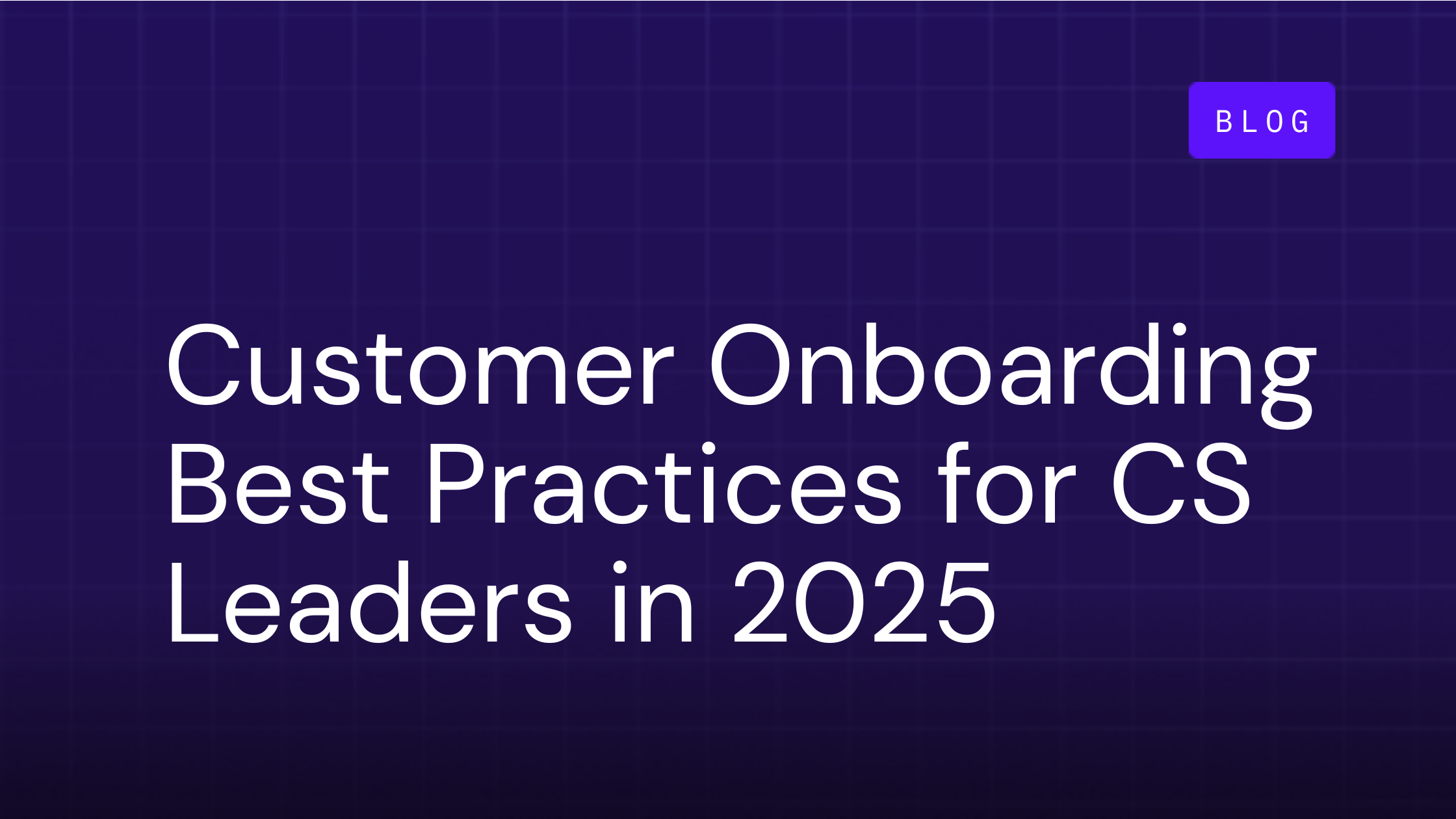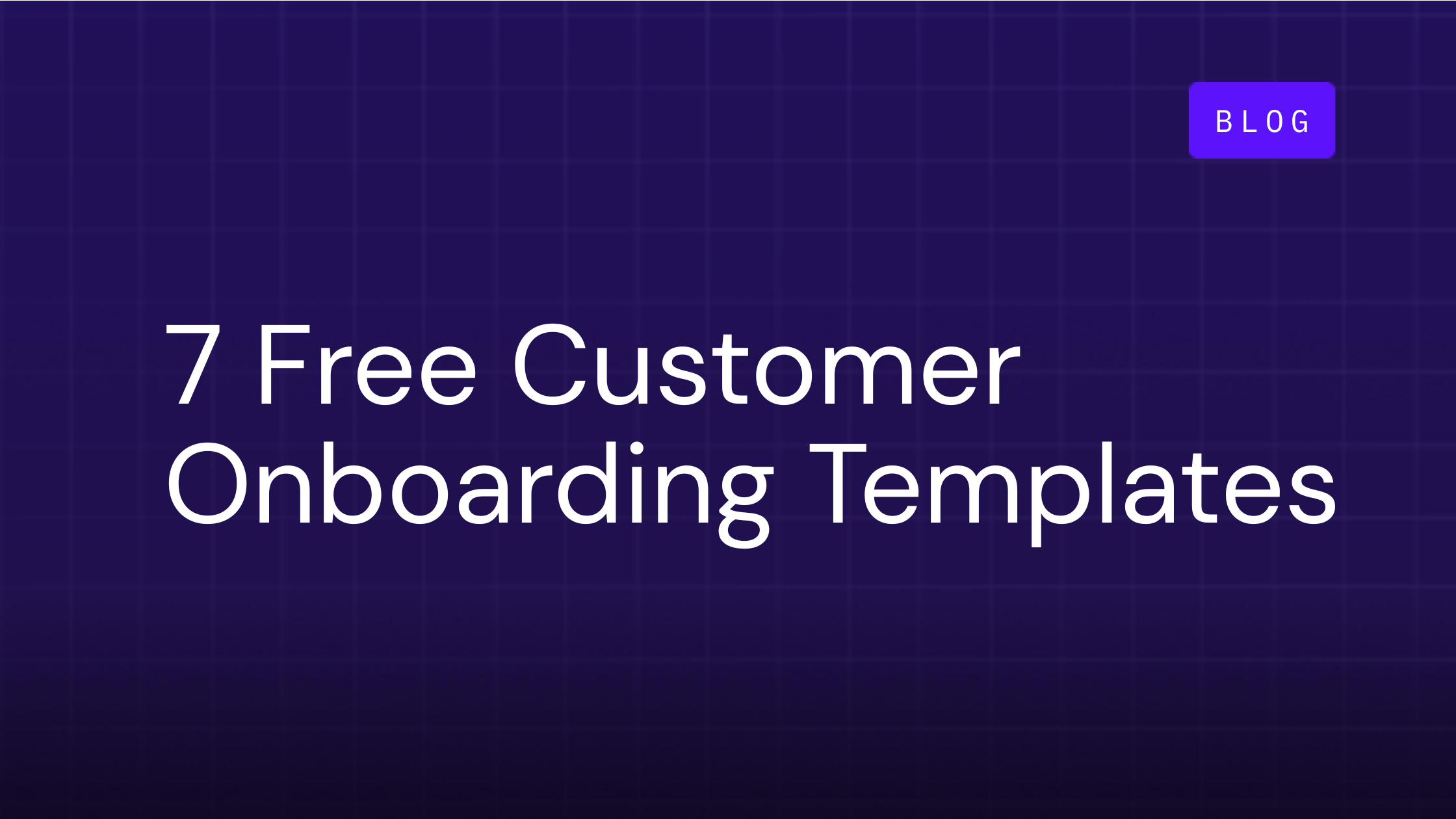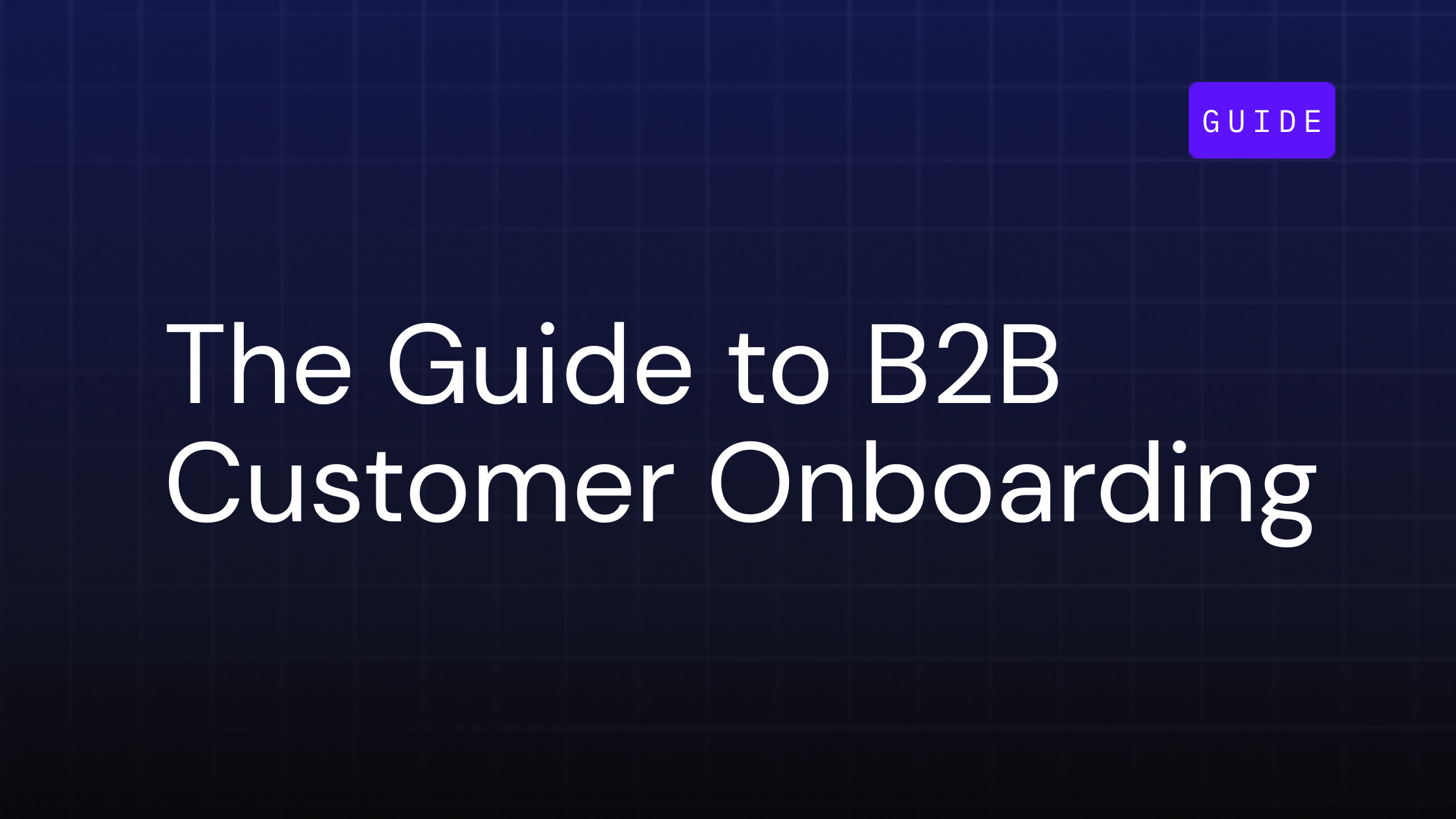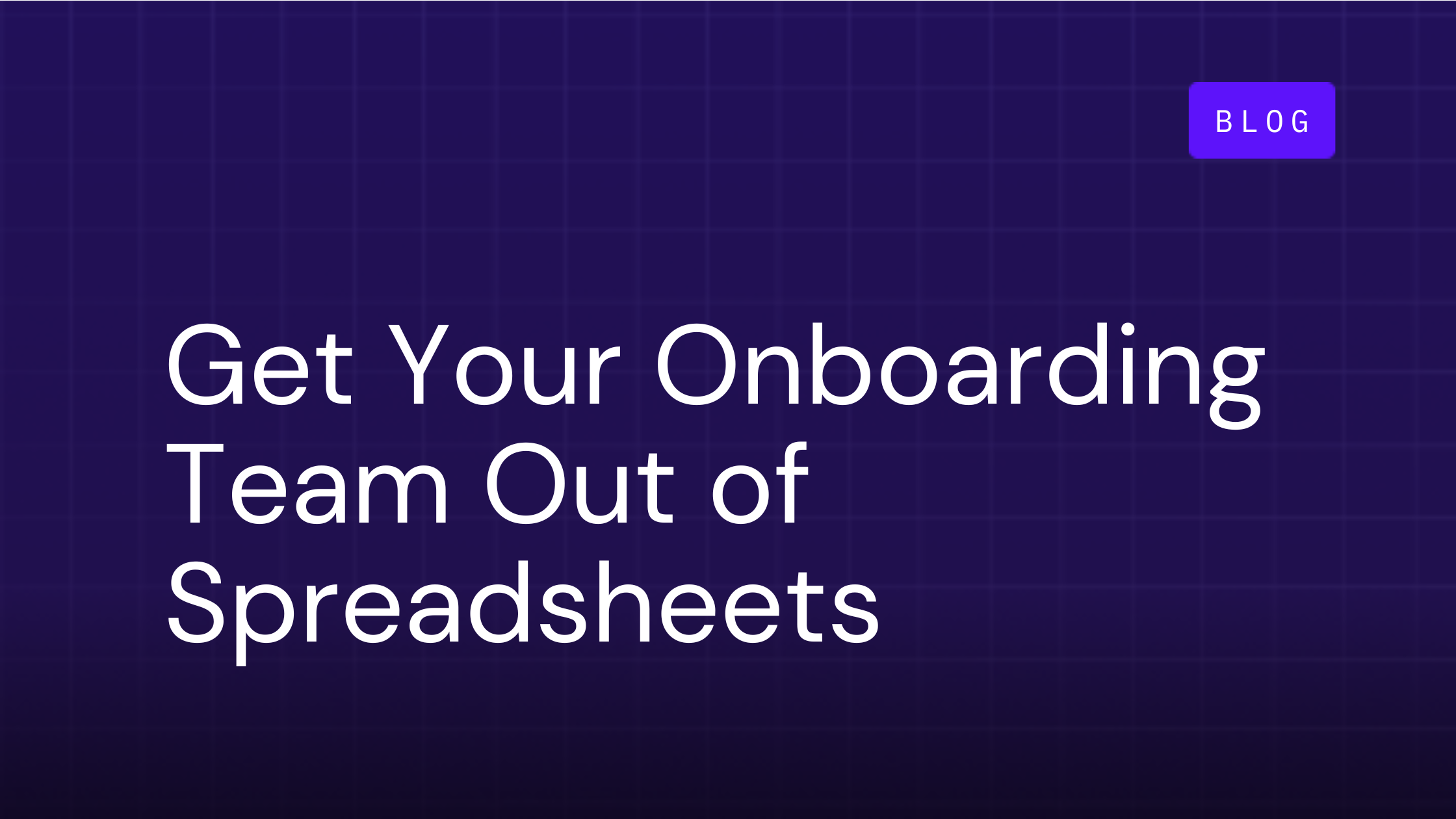Customer Onboarding Best Practices for CS Leaders in 2025
Published: December 17, 2024

Table of Contents
Onboarding new customers is a key revenue strategy for the sustained success of any B2B business in 2025. An optimized onboarding process sets the right expectations and sets you up for success to foster a long-lasting customer relationship.
However, with numerous elements involved, onboarding can easily become mismanaged. How can you construct an effective system? This article outlines a strategic approach, sharing onboarding customers best practices, grounded in proven methodologies.
The Importance of Customer Onboarding
Customer onboarding is the process of integrating new clients into your product or service. It encompasses implementation, training, and support, helping customers understand and can maximize the value from your offering.
For SaaS companies, effective onboarding is critical as it lays the foundation for customer retention and growth. Successful onboarding leads to subscription renewals and expanded usage, while poor execution results in customer churn. Therefore, prioritizing B2B customer onboarding best practices is essential.
Understanding the Psychology Behind Effective Onboarding
Grasping the psychological aspects of customer behavior allows businesses to design onboarding processes that resonate deeply with users, promoting long-term engagement. Effective onboarding achieves two primary objectives: educating customers on how to use your product efficiently and building trust through a compelling experience that fosters confidence and loyalty.
Key psychological principles include reducing cognitive load, which involves introducing features and information incrementally to prevent overwhelming customers. This strategy allows customers to build confidence with each small success, fostering a sense of achievement and forward momentum.
Building trust is equally important; it involves establishing credibility and a sense of partnership through transparency and reliability. By clearly communicating what to expect and consistently delivering on those expectations, businesses can create a foundation of trust that strengthens the emotional connection customers feel toward the product.
Another crucial element is creating “aha moments”—instances where users experience the value of your product in a personal and impactful way. These moments deepen the customer’s attachment to your solution, making them more likely to adopt it fully and advocate for it within their organization.
Additionally, onboarding should deliver tangible results by helping customers achieve measurable progress quickly. This will reinforce the value of your solution and confirm their decision to choose your product.
By blending these psychological principles with structured onboarding strategies, businesses can create experiences that resonate on both emotional and practical levels. In B2B customer onboarding, where multiple stakeholders must be aligned, addressing these psychological drivers can transform short-term usage into long-term success.
Laying the Foundation for Success
The initial days of onboarding are crucial. This period sets the tone for the entire customer relationship, allowing customers to feel supported and confident as they begin their journey with your product.
Immediate Engagement:
As soon as a customer signs up, sending a personalized welcome email is essential. This email should be friendly and informative, setting expectations and introducing the next steps in the onboarding process. Following this with a kickoff call within the first few days allows you to align on goals, address any immediate questions, and establish a clear path forward.
Seamless Handoff Between Sales and Customer Success:
Clear communication of customer needs and objectives between the sales and customer success teams is essential. This prevents redundancy and frustration, enabling your team to start with a comprehensive understanding of the customer’s requirements.
Creating Early Wins:
Helping customers achieve tangible results within the first 30 days reinforces the value of your solution. For example, guiding a customer to complete their first successful project setup or delivering a key report can confirm to them that they made the right choice, building excitement about the journey ahead.
By focusing on immediate engagement, seamless handoffs, and early wins, you create a foundation that fosters customer satisfaction and long-term success.
Writing Clear Tasks and Reducing Friction
A seamless onboarding experience requires clear, actionable tasks and minimized friction points.
Clear Task Instructions:
Breaking down complex workflows into manageable steps is vital. Instead of overwhelming customers with an exhaustive setup all at once, present only what’s necessary at each stage.
For instance, rather than requiring users to configure an entire system upfront, introduce features incrementally, allowing customers to learn and adopt them at their own pace. Providing specific, concise, and goal-oriented directives empowers users to move forward with confidence. It reduces the need for unnecessary support inquiries.
Minimizing Unnecessary Complexity:
Streamlining processes to eliminate bottlenecks is equally important. Avoid requiring customers to navigate multiple systems or enter redundant data, which can create delays and frustration. Utilizing tools like onboarding portals can simplify interactions, making every step of the journey feel seamless.
Celebrating Milestones:
Implementing progress markers such as completion badges or congratulatory messages helps maintain motivation. For example, notifying a user when they finish their first module can significantly enhance their perception of the process, encouraging them to continue progressing.
Ultimately, clear tasks and a friction-free experience make onboarding easier and show customers that their time is respected. A well-designed onboarding journey creates momentum, fosters confidence, and allows users to quickly realize the value of your solution.
Building Relationships for Long-Term Retention
Onboarding is the foundation for a lasting relationship that drives long-term success.
Building Trust Through Transparency:
Clearly outlining milestones, timelines, and support structures during onboarding helps establish credibility.
When expectations are communicated and consistently met, customers are more likely to see your organization as a reliable partner, not just a vendor. This trust is essential in the B2B space, where relationships often span years and involve high stakes.
Proactive Communication:
Maintaining regular, meaningful touchpoints throughout the onboarding process reinforces the customer’s decision to partner with you. Personalized emails, scheduled check-ins, and tailored resources keep the conversation active and demonstrate that your team is invested in their success.
Personalization:
Tailoring onboarding experiences to each customer’s unique goals, challenges, and workflows shows that their success is your priority. For example, onboarding a small startup may involve more hands-on guidance. Larger enterprises might benefit from customized implementation plans and deeper integration support.
Strong relationships established during onboarding lead to opportunities for upselling, cross-selling, and advocacy, transforming customers into loyal advocates.
Leveraging Data Analytics for Optimization
Data analytics is essential for continuous improvement in customer onboarding.
Identifying Bottlenecks: Tracking user activity helps pinpoint where customers encounter difficulties, whether it’s during account setup, product integration, or feature adoption.
Addressing these sticking points with targeted solutions, such as enhanced tutorials or in-app walkthroughs, can significantly improve the flow of onboarding.

Key Metrics to Monitor:
- Time to First Value (TTFV): Measures how quickly customers achieve their first meaningful outcome.
- Activation Rate: Tracks the completion of core actions that signify initial adoption.
- Churn Rates: Monitors customer retention during and after onboarding.
Utilizing platforms like OnRamp can help harness these insights to refine and optimize the onboarding process continually.
Personalizing the Onboarding Journey
In today’s competitive landscape, personalization is paramount for effective onboarding.
Customer Segmentation:
Grouping customers based on criteria such as company size, industry, or specific use cases allows you to craft onboarding paths that address their distinct needs.
For instance, customers in highly regulated industries may require extensive compliance support. Those with niche use cases will benefit from tailored onboarding paths to address their unique requirements.
Hybrid Approach:
Combining automation with human interaction balances onboarding efficiency and personalization. Automated tools, such as in-app tutorials or triggered emails, provide consistency and scalability, while personalized check-ins or tailored recommendations from a customer success manager foster trust and deepen engagement.
Onboarding Portals:
Providing a centralized hub where customers can track progress, access resources, and communicate with your team enhances their sense of control and engagement. This empowers customers to take an active role in their success and streamlines the onboarding journey.
Personalized onboarding fosters long-term relationships, promoting alignment across stakeholders and accelerating product adoption.
Scaling Onboarding for Growth
As your business expands, scaling the onboarding process without compromising quality is essential.
Onboarding Automation:
Automating repetitive tasks like account setup and basic training increases efficiency. Utilizing automated email sequences and in-app tutorials guides customers through initial steps. This frees your team to focus on high-impact, relationship-driven interactions.
Self-Service Onboarding Options:
Offering comprehensive knowledge bases, video tutorials, and FAQs empowers customers to resolve common issues independently, reducing the strain on support teams. Guided onboarding experiences through interactive platforms allow users to explore features at their own pace.
Streamlined Workflows:
Coordinating tasks across teams with clear processes and robust tools promotes cohesive and efficient onboarding efforts. Platforms like OnRamp enable businesses to create scalable workflows, maintaining quality even as customer volumes increase.
Balancing scalability with personalization ensures each customer receives a tailored onboarding experience, even as your user base grows.
Continuous Feedback and Iteration
A dynamic onboarding program evolves through continuous feedback and iterative improvements.
Gathering Feedback:
Conducting regular surveys and check-ins during and after onboarding collects actionable insights. Open-ended questions, such as “What challenges did you face during onboarding?” or “What additional resources would have been helpful?” uncover pain points that might otherwise go unnoticed.
Implementing Changes:
Using customer feedback to identify patterns and refine processes enhances clarity and reduces friction during onboarding. For example, if multiple customers report confusion about a particular feature, enhancing your tutorials or adding an in-app walkthrough can address the issue effectively.
Cross-Departmental Collaboration:
Sharing feedback across sales, product development, and marketing teams helps onboarding reflect customer expectations and aligns with broader business goals.
Fostering a culture of customer-centricity through continuous feedback and iteration keeps your onboarding program effective and relevant.
Measuring Success and Initiating Renewal Conversations Early
Measuring the effectiveness of your onboarding process and starting renewal conversations early are critical for customer retention.
Defining Key Performance Indicators (KPIs):
Tracking metrics such as time to first value, feature adoption rates, and churn rates assesses onboarding success. These indicators provide insights into how quickly customers are realizing the benefits of your product and highlight areas for improvement.
Early Engagement for Renewals:
Initiating renewal conversations during onboarding through regular check-ins and progress assessments establishes your company as a partner invested in the customer’s long-term success. This proactive approach allows you to address potential challenges before they become renewal barriers.
Positioning Renewals as an Extension of Success:
Highlighting measurable outcomes and demonstrating ongoing value builds confidence in the relationship. Engaging multiple stakeholders, especially decision-makers, leads to the value proposition resonating across the customer’s organization.
By integrating these practices, onboarding becomes a launchpad for long-term partnerships, driving retention and growth.
Enhance Your Customer Onboarding with OnRamp
Optimizing the customer journey extends beyond onboarding. Innovative solutions like OnRamp enable scalable workflows between teams, creating a seamless onboarding experience.
OnRamp offers a specialized customer onboarding platform that customer-facing teams use to onboard new clients. It provides two integrated interfaces – an advanced project management system for internal teams to track onboarding deliverables and a user-friendly customer onboarding portal for clients to interact seamlessly.
Discover how OnRamp can elevate your customer onboarding. Schedule a demo today to identify and eliminate onboarding bottlenecks, delivering tailored, white-glove experiences for each customer.
Related Posts:

Scaling Customer Onboarding: 7 Free Customer Onboarding Templates
Unlocking the potential of your business begins with establishing a seamless onboarding process for new clients. Whether you're a...

What is Customer Onboarding? The Guide to B2B Customer Onboarding
Customer onboarding is one of the most critical phases in the customer journey, yet it’s often the most overlooked. Done well, it...

How To Get Your Customer Onboarding Team Away From Spreadsheets
No offense to Google Sheets, but when it comes to delivering a customer onboarding experience, it’s not where spreadsheets excel....